| By: Paul S. Cilwa | Viewed: 4/26/2024 Occurred: 9/2/2021 |
Page Views: 672 | |
| Topics: #Coronavirus #Covidiots #HumanSubspecies | |||
| Why 60% of humanity cannot understand the other 40%. | |||
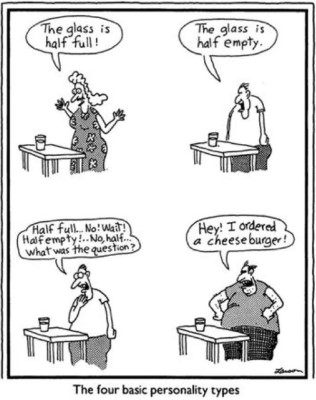
Most people, even if they paid little attention in high school biology, have a working understanding of the concept of species. That is, they understand that animals of two different species cannot mate, or at least, cannot mate and produce babies. Or, if somehow they do, the babies will not be able to have babies of their own (as is the case with the offspring of a horse and a donkey; we actually call all such infertile inter-species offspring "mules"). However, those who did pay attention know there's a lot more to it than that. And in those extra details you may find an explanation for the otherwise inexplicable behavior of the intentionally un-vaxxed "covidiots" so eagerly killing themselves for no good reason.
Taxonomy
Taxonomy is the general term for naming things according to some kind of plan. For example, in ancient Greece, Aristotle classified beings by their parts, or in modern terms attributes, such as having live birth, having four legs, laying eggs, having blood, or being warm-bodied. He divided all living things into two groups: plants and animals. Some of his groups of animals, such as Anhaima (animals without blood, translated as invertebrates) and Enhaima (animals with blood, roughly the vertebrates), as well as groups like the sharks and cetaceans, are still commonly used today.
However, it was Carl Linnaeus, some 2000 years later, who, relying on the cumulative work of all the biologists who preceded him, came up with a naming system so well-grounded in reality that it still holds with very few corrections, even in today's era of DNA-based taxonomy. In other words, it's Linnaeus' system that we still use today, simply using DNA analysis to determine ancestry instead of just relying on appearance. (It's thanks to DNA mapping that we now know the Greater Panda and the Lesser Panda are not, in fact, related to each other at all. But that was an extremely rare case.)
Scientific Classification
It takes eleven levels of classification to unequivocally identify a species. The full name includes the entire mapping, from whether it's a plant or animal (or, for that matter, a mineral). In the case of humans, these levels are:
| Kingdom: | Animalia |
| Phylum: | Chordata |
| Class: | Mammalia |
| Order: | Primates |
| Suborder: | Haplorhini |
| Infraorder: | Simiiformes |
| Family: | Hominidae |
| Subfamily: | Homininae |
| Tribe: | Hominini |
| Genus: | Homo |
| Species: | Sapiens |
In ordinary usage, however, we don't bother with anything but the last two, other than when trying to understand a species' trait by studying it in an ancestor or cousin species.
Binomial Nomenclature
Binomial Nomenclature is the term for the two-part mapping system used to name a species by prefixing its genus. For example, the Sapiens (wise) species of the Homo (Latin for "man") genus includes us, as it also includes (in most taxonomies) Homo Neanderthalensis.
Probably the most important takeaway from this is that the more inclusive levels of scientific classification—whether a particular thing is an animal or a rock—are really not up for debate (unless one is discussing pandas). Even the genus is pretty definite, unless an utterly new genus is discovered, which rarely happens. But the actual species name can, and often is, dusted with a bit of whimsy. If you're famous, a scientist may honor you with, say, a spider, a la Myrmekiaphila neilyoungi, or the tapeworm Acanthobothrium zimmeri, recently named for science writer Carl Zimmer.
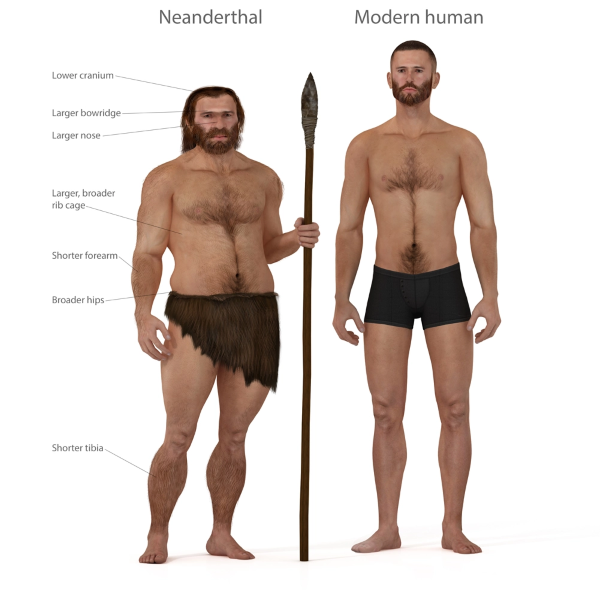
More germane to this discussion, however, is the fact that sometimes species that were originally thought to be distinct (for example, Homo sapiens and Homo neanderthalensis) turn out to be not so distinct after all. Remember, two different species cannot mate and produce fertile offspring—that's pretty much the definition, right there. But modern DNA testing has shown conclusively that modern humans include a fair percentage of Neanderthal genes. That means that our ancestors and the Neanderthals were not only doing the nasty and having kids, but so were their resulting kids. That means they—we—had to be of the same species.
And yet, they were so different!
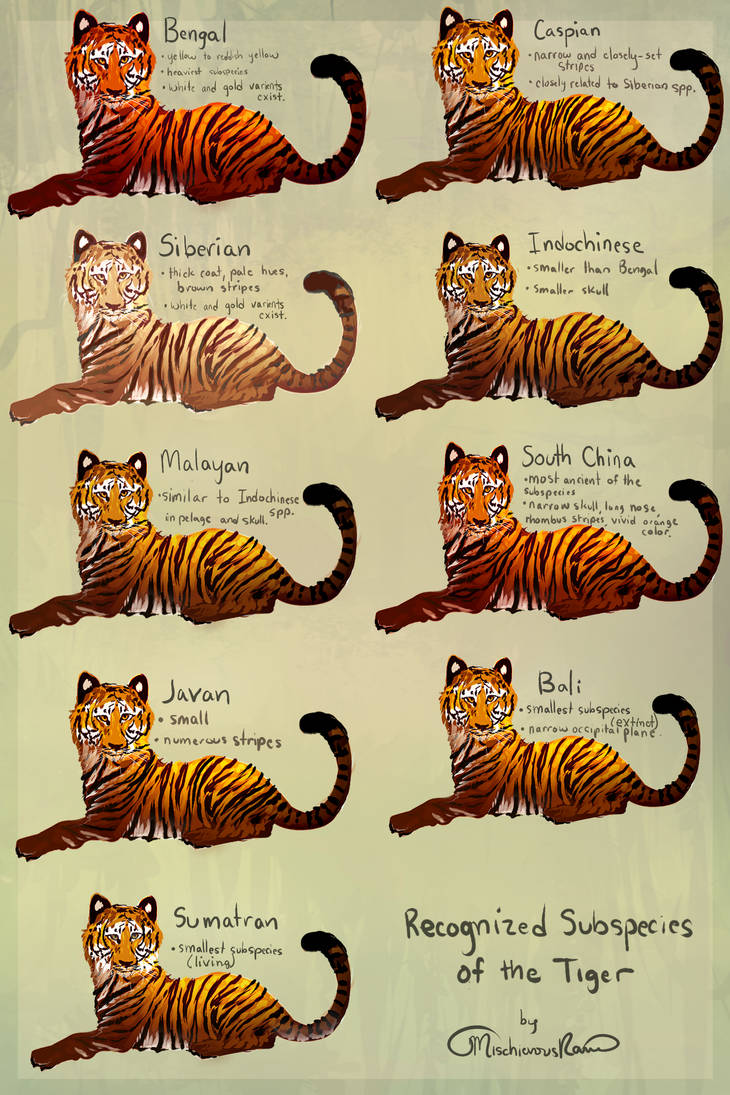
To accommodate this sort of conundrum, the idea of subspecies was introduced. Two subspecies of the same species will have enough similarities to allow mating and fertile offspring, but also enough differences to discourage it. For example, millions of years ago, there was just one species of wren occupying the area we now call Grand Canyon. When the great uplift occurred and the Colorado River carved out the 25-mile-wide canyon, the wrens on the north side and on the south side diverged. They still can mate; but in the wild, they don't bother to make that trip.
So, by adding a third part (a trinomial nomenclature), we can specify Homo sapiens sapiens (that's us) and Homo sapiens neanderthalensis. (There's no magic to repeating the species name as the subspecies name. It usually just refers to the most common manifestation of a species.)
Generally, subspecies differ due to specific adaptations to different climates or ecosystems.
Are different human races or dog breeds a subspecies?
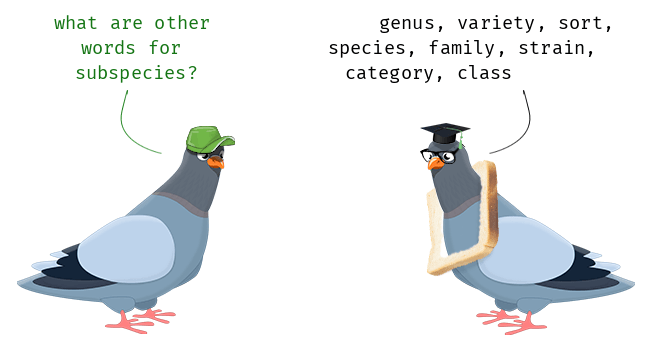
The short answer is no. A subspecies has enough differences to lead to its eventually becoming a completely independent species. Anyone who's seen a Chihuahua fall in love with a Great Dane knows breeds are no barrier to romance. Similarly, given the many, many "interracial" marriages out there, we can see this is something only racists would avoid. So it's not people who intermarry that are the Homo sapiens dead ends; it's the racists who will either go extinct or branch into their own independent species.
Similarly, if humans have current subspecies, they would likely be due to the personality differences that drive political differences. The Trump era broke up many marriages and friendships, and has caused rifts in many families. Profiles on dating sites make clear which side of the fence that the dater is on. And from the Twitter posts I've read, MAGAts will not date a "libtard" and no one with a brain would have anything to do with a MAGAt. So we're in a subspecies-creating situation right now.
The only question is, is this new? Or merely the triggering event for differences that were already here?
Genesis Revisited
That brings us to Zecharia Sitchin, who was raised in Palestine, where he acquired a profound knowledge of modern and ancient Hebrew, other Semitic and European languages, the Old Testament, and the history and archaeology of the Near East. Sitchin's basic premise is that the Sumerians, who claimed to have been created by a race of "gods" from another planet in this Solar System, were correct.
This premise is easily tested; if the Sumerians were, indeed, given knowledge by advanced aliens, that knowledge should be more correct than otherwise possible…and, sure enough, their astronomical tables include accurate orbital information for all the planets, including Uranus, Neptune, and even Pluto—the three planets of our Solar System that are not visible to the naked eye. (They were not re-discovered until 1781, 1846, and 1930, respectively.) Even the major moons of Jupiter, re-discovered by Galileo in 1610, were known to the Sumerians!
This proof of their scientific knowledge demands that we take their other stories, if not at face value, at least with an open mind and inquisitive attitude.
Our stories in Genesis are, in fact, Reader's Digest-like abbreviations of the original Sumerian tales of mankind's creation. AD.AM is Sumerian for "Prototype Worker". E.DIN means "Laboratory in the South" (Africa's Rift Valley, the location of the real Garden of Eden). Eve wasn't made from Adam's rib; she was made from his TI, which in both Sumerian and Hebrew mean both "rib" and DNA (or, more literally, "life design").
According to the unabridged Sumerian stories, which they said were dictated to scribes by the Nibiruans themselves, the Nibiruans originally came here for gold, which they pulverized into monatomic molecules that would suspend in their stratosphere and hold in heat during their 3500-year-long winter, while keeping it from getting too hot during their century-long summer. Nibiruan astronauts, called Nefilim, were seduced by money and a sexy-sounding job but found themselves pressed into service as gold miners in South Africa. (Those mines, or their remnants, are still there, too old to have been dug by modern humans.) So they mutinied.
That was under the command of a Nibiruan prince named Enlil. His half-brother, Enki, was second-in-command; and they pretty much hated each other. They certainly never agreed. Enlil's original suggestion had been to extract the golf from seawater using electrolysis. His system worked, but not fast enough to save Nibiru from its climate crisis; so Enki's father sent Enlil. Enki expected Enlil and the Nefilim to build more extraction stations; but Enlil was intent on mining, thus leading to the mutiny.
With nothing else to do while his brother was playing slave-owner, Enki explored his new world. One of his areas of expertise was genetics, and he became interested in Homo heidelbergensis, recognized as Homo sapiens' immediate ancestor. This hominid was about the right size, and had the necessary manual dexterity, to operate the Nibiruans' machinery, if only they could be made bright enough, and given the necessary motivation. So Enki, with the assistance of his half-sister, Nin (Lady) Hirsag, added some Nibiruan DNA to the mix, got Nibiruan "birth goddesses" to host the fetuses, and produced the first attempt at a Nibiruan/Terrestrial hybrid.
We call this result Neanderthals, although the first effort might instead have been the Denisovans, whose DNA we also carry. Either way, the Nibiruans called this first model, Lilith. But it was too smart. It was properly awed by the aliens (built into the Lilith's DNA), but was too clever to want to work for someone else without getting something out of it.
Homo sapiens servitus

The next effort wasn't quite as smart but were far more docile. (Homo sapiens neanderthalensis had an average brain size of 1200 cubic centimeters; ours are about 1000 cc.) That first, original version of anatomically modern humans, also known as Cro-Magnon Man, was Homo sapiens servitus, Man The Knowing Slave.
The attributes of this chimera, with its 223 genes that exist in no other earthly species, include the following:
- Will blindly obey the authority to whom they've given their loyalty, whether person, dogma or ideology, even if it's dangerous or fatal to do so.
- They operate on the basis of fear-avoidance at all costs, refusing to see evidence, even of their own senses, that their authority can do any wrong.
- If their authority actually does something the servitus had thought was wrong, servitus will modify their moral code so that the authority is now in the right.
- Servitus is a linear thinker, That means, they can only process a new piece of information if it fits firmly on a bedrock of things they already believe to be true. Thus, an early lie becomes part of servitus' world view, and virtually impossible to change.
- One of Servitus' early tasks was to eliminate the Neanderthal and Denisovan failed experiments, which were already thriving in their new environment out of the Garden. They mustn't be allowed to proliferate and contaminate the new species. So Servitus was built with a violent fear of anyone different than them. And within a hundred thousand years, the Neanderthals and Denisovans were just a few buried bones.
Enlil, by the way, as "Lord of the Command" was not pleased when he discovered his brother, supposedly his inferior, had again solved a problem using science, that Enlil couldn't manage by force. But, given the mutiny, there wasn't much he could do but accept his brother's willing worker species as his new labor force. It was Enlil who, as "Lord of the Gods" (abbreviated in the King James' translation as "Lord God") walked with Adam, the first prototype worker, in the Garden. He feared the new creation would get too smart and independent, as Lilith had, and become a threat to the Nibiruans, so forbade Enki to allow the new ones to become fertile.
At the time, and even since, the euphemism "knowing" has meant having sex, especially if it results in pregnancy. While Americans talk of the "birds and bees", most of the word refers to having that talk with the kids as giving them "knowledge".
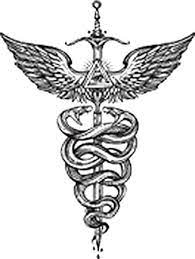
Each of the Nibiruans had a symbol or logo, sort of like Superman's family crest (which resembles our letter 'S'). Enki's was two serpents wrapped around a rod, an obvious metaphor for DNA, which we today call the caducius. It now symbolizes medicine; but in his day it gave Enki the nickname, Serpent.
The Tree of Knowledge wasn't a real tree; it was a metaphor for Enki, the Serpent, giving the ability to procreate to his new species. (That's why, in the story, Adam and Eve suddenly become body conscious.)
These people, still with us today, make up about 30% of the population. They are not all MAGAts; some are actually liberal in their responses. But Servitus liberals are liberals because that's how they were raised. They know what they should think, so they think that. Rather than an individual, they have given their loyalty to an idea. But it's still mindless. (You often find such people in academia.)
Homo sapiens rex

As humans procreated and spread widely, they had to be fed and housed to keep them available for work. Each time Nibiru made another close pass to Earth--every 3600 years--the Nibiruans would gift new technology to the slaves. First agriculture, then the domestication of food animals, then cities. But so many humans were causing logistics problems of their own, and demanding constant attention from their masters, that Enki decided to come up with a new variant: Homo sapiens rex, Man Who Knows He's King.
The original job of these folks was Priest, a simple go-between so the Nibiruan wouldn't have to be accosted on the street by someone wanting him to save their kid from plague, or something. That's why they have charisma and exceptional communication skills. But as humanity continued to spread—we were designed to be very prolific!—and the number of priests grew large enough to need their own management, the Nibiruans introduced the concept of Kingship, and Rex proved to be perfect for that job. In today's world, Rex is also the corporate CEO.
This subspecies was designed to run things, and to do so optimally without hesitation or emotionalism. Consequently Rex people are sociopaths (with an inability to relate to others on an emotional level). To a king, this is a necessary trait. An empathic person would hesitate, perhaps disastrously, to allow one block of people to die so that another, larger, block could live. A sociopath not only has no problem with that (except in how it will look in the papers), but can give the order during desert without even losing his appetite.
But without the steadying hand of a Nibiruan mentor, a Rex is likely to ignore future consequences in favor of a quick win or quick profit. And that's why we currently have a climate crisis, as well as an out-of-control pandemic.
Rex currently is found in about 10% of the population. Your crazy, narcissistic, ex-boyfriend with borderline personality disorder? Yeah, he's a Rex. Your boss probably is, too, which is why it's such a good idea to never have an affair with one.
Homo sapiens noeticus

The remaining 60% are what I call Homo sapiens noeticus. We came about after the Sumerians' time, but I can guess what happened. It's clear Enki has the soul of an artist. I think he decided it would be good for the Nibiruans to have an equal, and perhaps an ally in a war with a new enemy that appeared and quickly drove all the Nibiruans, literally, underground. So he went back to his genetics workshop and began tweaking the genomes of various individuals. (This is what happens during an "alien abduction". The abductions are a breeding program.)
This process has been going on for hundreds of years, at least. But, as with any subspecies, Noeticus tends to want to hang out with other Noetici. We simply can't understand anything Servitus says, and we find Rex to be too scary to live with (even if they're usually amazing in bed).
Other traits:
- Too much of an independent thinker to follow anything blindly. A Noeticus may well belong to a church, but it will be to provide service to the community rather than actually worship anything.
- Values justice over revenge, and love over fear. Personal experience is valued while dogma is inherently suspicious.
- Respects and understands the need for leadership, but demands a high moral standard of anyone, Rex or otherwise, who finds themself in that position.
- Noeticus is a matrix thinker. That means we voraciously gather random information, which mentally get stored like cells in a spreadsheet. When two adjacent cells are filled, it sort of gives us a thrill to make the connection, And as more and more adjacent cells fill, the thrill gets bigger and bigger. We call that an epiphany, and that joy is what keeps us learning.
- We also love diversity in our friends, and our world. Rather than avoid people different than us, we tend to seek them out.
Obviously from my use of the word "we" I consider myself to be a Noeticus but I'll bet you are one, too.
Otherwise you would never have gotten this far. Servitus cannot bear to read or hear anything that conflicts with what they already believe. And Rex isn't interested in anything that doesn't directly contribute to their bottom line.
Which means, if we Noetici want to keep this world livable for us, we're the ones who'll have to step up and make it happen, for us as well as Servitus and Rex…despite the fact that they will fight us on this every step of the way.





